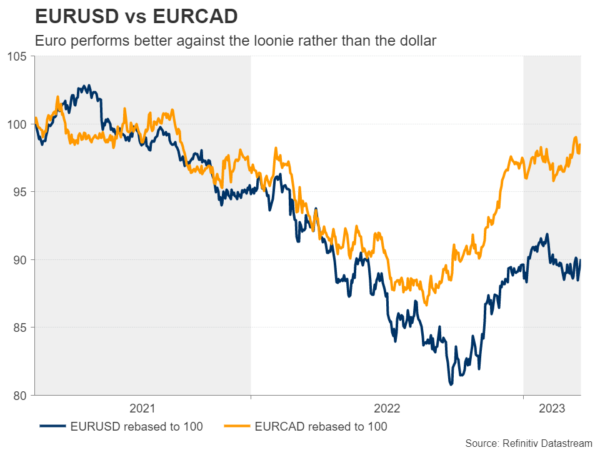Following the market turbulence triggered last week by concerns about the stability of the global banking system, investors have been scratching their heads to figure out how central banks may proceed henceforth. The ECB disappointed those expecting a smaller-than-telegraphed hike at its last meeting, turning the spotlight to incoming data for its future decisions. With that in mind, euro traders may now lock their gaze on the preliminary Euro area PMIs for March, due to be released on Friday at 09:00 GMT.
To hike or not to hike?
At last week’s gathering, the ECB decided to deliver the previously promised 50bps hike, disappointing those expecting a smaller increase or no increase at all due to the turmoil in the banking sector. At the press conference following the decision, President Lagarde dismissed the idea that the efforts intended to bring inflation to heel are a threat to financial stability, arguing that the Euro area banking system remains resilient and that, if anything, higher rates could bolster margins.
Nonetheless, in the official statement accompanying the decision, the commitment for future rate rises was dropped, with Lagarde later stressing that they will base their future decisions on data. With that in mind, some investors started pricing in the probability of no action at the Bank’s May meeting. At some point on Monday morning, they were nearly certain about that.
On the same day, Lagarde said that the turmoil may do some of the ECB’s work if it dampens demand and thereby inflation, adding credence to expectations of a much slower rate path hereafter. However, she also noted that interest rates will remain the ECB’s main tool for inflation, while for the banking sector, the Bank can utilize existing lending facilities or construct new ones. This suggests that the probability for a hike at the May meeting may be higher than the one initially assigned by the market. Indeed, currently investors see an 80% chance for a 25bps hike, with the remaining 20% pointing to a pause.
Will the PMIs enter the basket of data warranting more hikes?
Now, investors may be eager to see what incoming data will reveal regarding the performance of the Euro area economy and the future path of inflation and thus, they may pay special attention to Friday’s preliminary PMIs for March. The data for February showed that the composite index rose to an 8-month high, adding to hopes that the Euro area may have avoided a previously feared deep recession.
Although the surveys’ results showed that prices charged for goods and services rose at the weakest rate since December 2021, the CPI numbers for the month painted a different picture. Yes, the headline rate continued declining, but much less than the forecast suggested, while the core rate that excludes energy, food, alcohol and tobacco rose to a fresh record high.
On Friday, the manufacturing index is forecast to have increased to 49.0 from 48.5 and the services to have slid somewhat, to 52.5 from 52.7. This will drive the composite index a tick down to 51.9 from 52.0. With inflation in the Euro area still running hot, such numbers are unlikely to add to speculation for no action at the upcoming ECB gathering. On the contrary, should they be accompanied by rising prices’ subindices, they could prompt investors to increase their hike bets, something that could prove supportive for the euro.
Euro may continue performing better against the loonie
That said, euro/dollar may not be the best gauge for exploiting any potential euro gains, as with investors being so pessimistic regarding the Fed’s future course of action and US inflation running at three times the Fed’s target, the risks arising from Wednesday’s Fed decision may be tilted to the upside. With the Bank of Canada already hitting the pause button and investors expecting only rate reductions henceforth, the loonie may be a better choice.
Euro/loonie has been in a recovery mode since March 15, when it tumbled and hit support at 1.4480. Overall, the pair is trading above the uptrend line drawn from the low of September 26, which suggests that the pair may continue drifting north for a while longer.
Currently, the pair is oscillating around the high of March 13 at 1.4760, the break of which would confirm a higher high on the daily and bigger timeframes. Such a break could see scope of advances all the way up to the 1.5100 zone, which acted as a ceiling between July 19 and September 20, 2021. If that area fails to stop the bulls this time around, a test near the high of April 21, 2021, at 1.5190 could be possible. Should this zone be violated as well, then the trend might continue towards the high of February 26, 2021, at 1.5385.
On the downside, a dip below 1.4480 could also signify the break below the aforementioned uptrend line, which could encourage the bears to put the 1.4240 zone on their radars. If they manage to reach and breach that territory, they may decide to extend their dive towards the round figure of 1.4000.



















